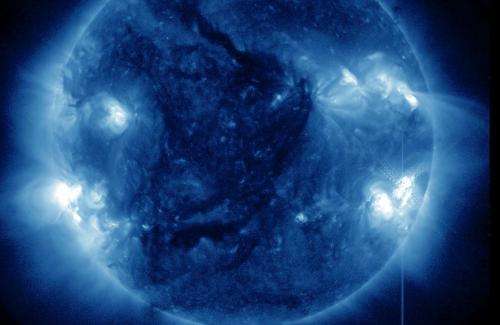The Sun blasts out an X1-Class solar flare

An active region on the Sun, AR1515, has been putting on quite a show over the last 8 days, sending out all sorts of solar flares. Scientists were sure the huge sunspot was building up to produce an X-class explosion, and they were right. At 23:08 UT on July 6, 2012 it unleashed an X1-class solar flare. The explosion hurled a coronal mass ejection into space, and scientists say the cloud appears to be heading south and away from Earth; however, there is the possibility of a glancing blow to our planet on July 8th or 9th. There could be some auroral activity today, July 7, from a previous batch of CME’s hurled from the same active region.
According to the Solar Dynamics Observatory team, the movie above shows the X1 flare in various different wavelengths, which show different layers and temperatures. Each segment is about 30 minutes in real-time.
Below is another video from July 5-6, where AR1515 pulsed with with C- and M-class solar flares, about 14 flares in all:
“X1-class solar flare on the right, new active region on the left. Will the action continue?” asked Camilla_SDO, the mascot for the Solar Dynamics Observatory, via Twitter.
So, what’s the difference in the classes of solar flares and how could they affect us on Earth?
Flares happen when the powerful magnetic fields in and around the Sun reconnect. They’re usually associated with active regions, which we call sunspots, where the magnetic fields are strongest.
Flares are classified according to their strength. The smallest ones are B-class, followed by C, M and X, the largest. Similar to the Richter scale for earthquakes, each letter represents a ten-fold increase in energy output. So an X is 10 times an M and 100 times a C. Within each letter class, there is a finer scale from 1 to 9. Although X is the last letter, there are flares more than 10 times the power of an X1, so X-class flares can go higher than 9.
C-class flares are too weak to noticeably affect Earth. M-class flares can cause brief radio blackouts at the poles and minor radiation storms that might endanger astronauts. The most powerful flare on record was in 2003, during the last solar maximum. It was so powerful that it overloaded the sensors measuring it. They cut-out at X28. A powerful X-class flare like that can create long lasting radiation storms, which can harm satellites and even give airline passengers, flying near the poles, small radiation doses. X flares also have the potential to create global transmission problems and world-wide blackouts.
That’s why we keep an eye on all this activity.
Source: Universe Today




















